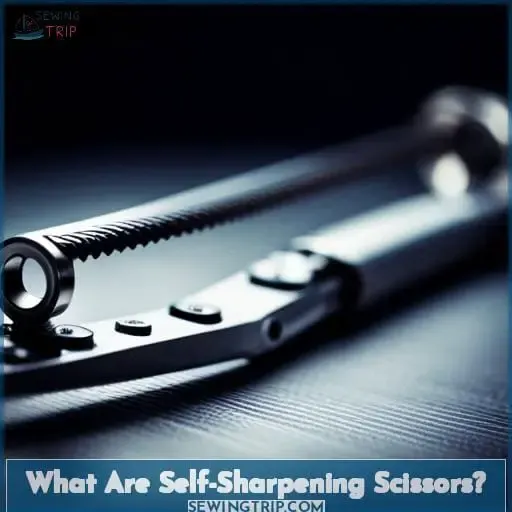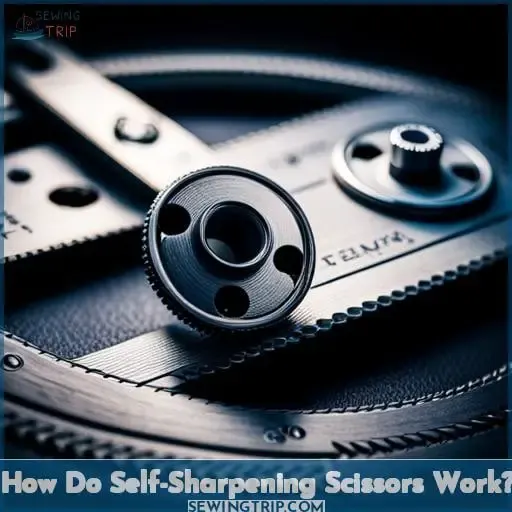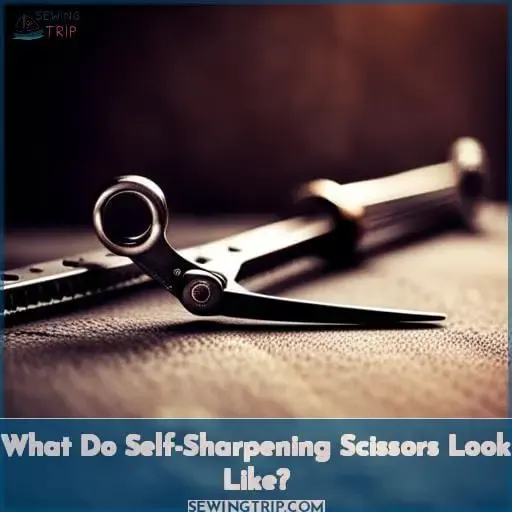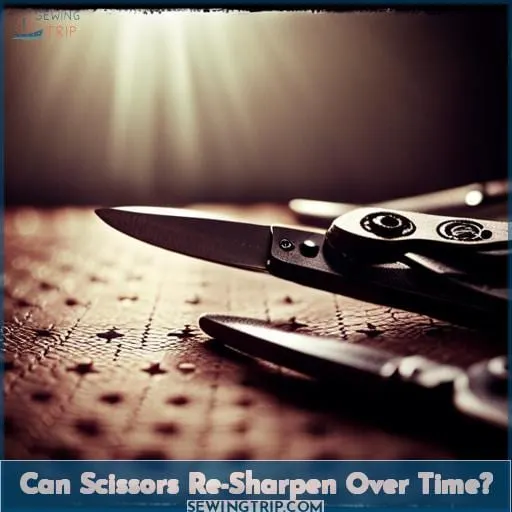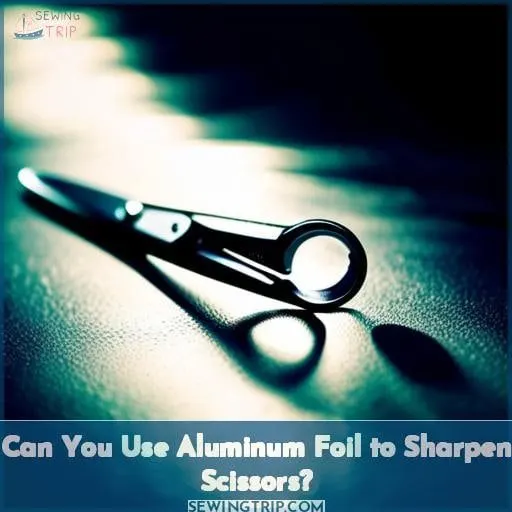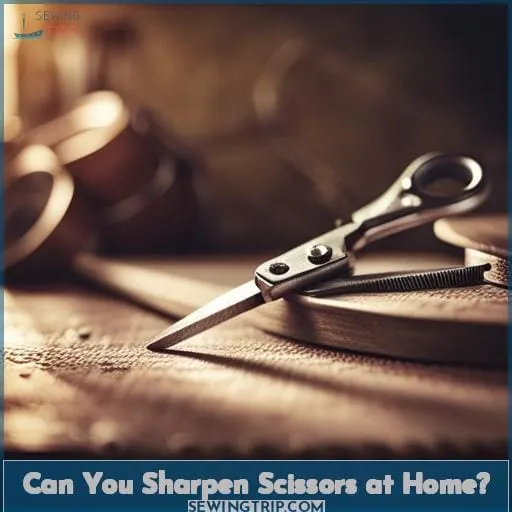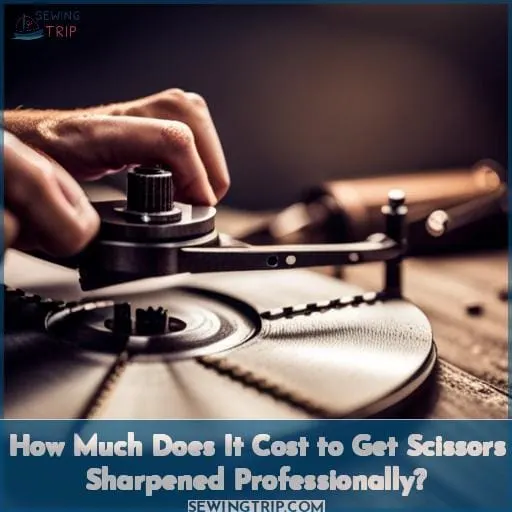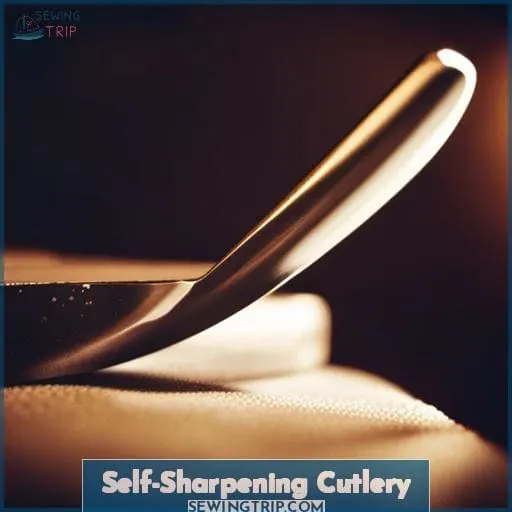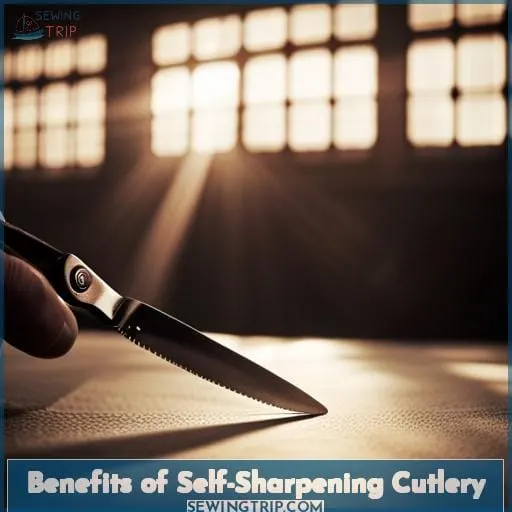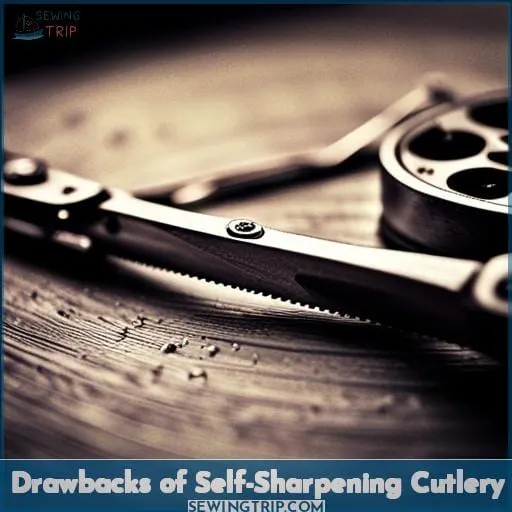This site is supported by our readers. We may earn a commission, at no cost to you, if you purchase through links.
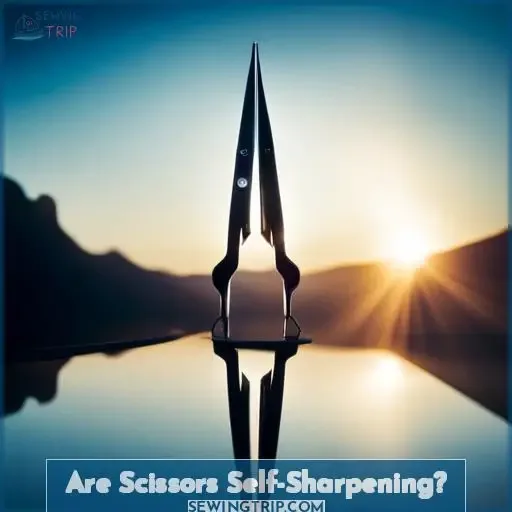 Are you curious about whether or not scissors can sharpen themselves? You may be surprised to learn that there are special types of self-sharpening scissors available on the market.
Are you curious about whether or not scissors can sharpen themselves? You may be surprised to learn that there are special types of self-sharpening scissors available on the market.
In this article, we will explore how these unique tools work and what other factors come into play in terms of sharpening your regular scissors at home.
We’ll also discuss professional sharpening services and take an in-depth look at self-sharpening cutlery: its advantages and disadvantages as well as how exactly it works.
So let’s dive right into: do scissors sharpen themselves?
Table Of Contents
- Key Takeaways
- What Are Self-Sharpening Scissors?
- How Do Self-Sharpening Scissors Work?
- What Do Self-Sharpening Scissors Look Like?
- Can Scissors Re-Sharpen Over Time?
- Can You Use Aluminum Foil to Sharpen Scissors?
- Can You Sharpen Scissors at Home?
- How Much Does It Cost to Get Scissors Sharpened Professionally?
- Self-Sharpening Cutlery
- Benefits of Self-Sharpening Cutlery
- Drawbacks of Self-Sharpening Cutlery
- Conclusion
Key Takeaways
- Self-sharpening scissors and cutlery use high-carbon steel, ceramic rods, and industrial diamond grit for sharpening.
- They maintain their edge about ten times longer than regular scissors and cutlery do.
- Regular maintenance involves cleaning debris, lubricating the pivot, and avoiding cutting unintended materials.
- Although more expensive, self-sharpening scissors and cutlery offer extended sharpness, reduced maintenance, and increased durability.
What Are Self-Sharpening Scissors?
You’ve got special scissors that sharpen themselves as you cut, so you don’t have to worry about keeping them sharp. The blades are made of high-carbon steel and coated with polytetrafluoroethylene for durability and non-stick cutting.
Tiny abrasive wheels are built into the pivot joint, sharpening the blades each time you open and close the scissors. Self-sharpening models maintain their edge about ten times longer than traditional scissors before needing professional honing.
Look for textured handles or labels like self-sharpening to identify them. Proper care is still required, like cleaning debris and lubricating the pivot monthly.
While the extra cost is worth it for many, some prefer resharpening traditional scissors as needed. Either way, staying on top of maintenance ensures you always have a perfectly sharp pair ready for your next project.
How Do Self-Sharpening Scissors Work?
Ever try self-sharpening ’em by gently gliding the blades across that tiny grinding wheel inside? The key to self-sharpening scissors is a small abrasive wheel lodged between the pivot joint. As you cut, subtle openings and closings of the blades cause them to rub against this wheel, wearing away microscopic amounts of metal to recreate a sharp edge after each use.
Here’s the clever mechanics behind the self-maintenance:
- Abrasion – The abrasive wheel shaves off tiny bits of metal like a mini file.
- Pressure – The spring tension provides the right amount of force for sharpening.
- Angle – The wheel is positioned at the ideal angle for sharpening the beveled blade edges.
Though convenient, the small sharpening wheels can wear down over time. Proper care and occasional honing helps self-sharpening scissors keep their edge for the long haul. But for day to day light use, they’re an innovative way to ditch the sharpening stones for good.
What Do Self-Sharpening Scissors Look Like?
Even experienced sewers seek out self-sharpening shears for their convenience and consistent performance. The key to identifying self-sharpening scissors is looking for the built-in sharpening mechanism.
Typically, these feature a ceramic rod attached to the blade that rubs against a hardened steel plate on the other blade with each cut.
Self-sharpening scissors are made from high carbon stainless steel or titanium for durability. Benefits beyond the self-sharpening include corrosion resistance and a non-stick coating that prevents gumming and buildup.
While more expensive initially, the self-maintenance and longevity make them a sound investment for avid crafters.
With some models offering a lifetime guarantee, self-sharpening scissors deliver reliable, fuss-free cutting power.
Can Scissors Re-Sharpen Over Time?
Though dulling blades may gnaw at your patience, honing your skills keeps sharpness from fading.
- Test often with paper – if it tears instead of slicing cleanly, it’s time to sharpen.
- Extend life through proper care – avoid cutting non-intended materials and store properly.
- Expect regular honing – sharpen every few months with a honing rod or your chosen method.
- Note the joint – a loose joint indicates worn hardware needing tightening or replacement.
- Upgrade when needed – very worn scissors may need professional sharpening or replacement blades/parts.
Regular sharpening and care keeps your trusted scissors slicing smoothly. But all scissors dull eventually from use, requiring honing to restore that clean cut. With practice, you can learn techniques like using a honing rod or aluminum foil to refresh edges between professional sharpenings.
Understanding materials like surgical steel and mechanics like the hand-set screw empowers you to maintain performance.
Can You Use Aluminum Foil to Sharpen Scissors?
You can fold aluminum foil and cut through it to sharpen your scissors in a pinch. While not as effective as whetstones or professional sharpening, this quick DIY method can rejuvenate dull blades when you lack proper tools.
Simply fold a sheet of heavy duty foil over a few times until it’s about six layers thick. Holding the scissors at your normal cutting angle, open and close the blades while slicing through the foil. The aluminum removes small burs and debris while straightening the cutting edge.
Make slow, full strokes from the pivot to tip. Check sharpness periodically. Repeat as needed, replacing the foil as it wears down. Though limited, this technique requires just household items, providing a cost-effective way to briefly revive your scissors’ slicing ability before professional sharpening.
Proper, regular blade care remains ideal, but aluminum foil can offer a workable quick fix.
Can You Sharpen Scissors at Home?
When your trusty scissors start to lose their edge, you can absolutely restore their sharpness at home rather than buying new ones. Use materials like sandpaper, whetstones, or honing rods to methodically hone and realign the blades along their original angles, taking care to apply even pressure across the length of the scissors.
Sandpaper
Rub the blades on 150-grit sandpaper to restore their edge. Apply even pressure and match the angle of the original grind. Scrub back and forth using the length of the blades. Refine with a finer grit once reestablished.
Thoroughly wipe debris off before use. Proper scissor maintenance with basic sharpening tools ensures precision cutting performance.
Whetstones
Stroke those stones evenly across the blade. Keep your sharpening angle consistent. Use a diamond stone first, then progress through finer grits. Clean the whetstones often and store them properly to avoid contamination.
Match the stone’s shape to the blade. Scissors sharpen best on wider, flat stones. Invest in a quality whetstone with leather protection. Source stones ethically. Do-it-yourself whetstone sharpening takes practice but yields professional results.
Honing Rods
Coarse honing rods can help in a pinch for maintaining your scissors’ edge. Using a honing rod takes some finesse. First, clean your scissors. Second, match the factory angle. Third, use smooth, even strokes.
Fourth, finish with a leather strop. Proper honing prolongs sharpness between full sharpenings.
How Much Does It Cost to Get Scissors Sharpened Professionally?
Paying a professional to sharpen your tools can bring peace of mind. Having properly sharpened scissors is crucial for many crafts and professions. While home sharpening is possible, the precision and expertise of professionals is unmatched.
- Consistent, even sharpening along the entire blade.
- Proper restoration of cutting edges and tip.
- Sharpening done at the ideal angles for your scissors.
- Advanced equipment like belt sharpeners or diamond abrasives.
- Avoid potential damage from amateur DIY attempts.
Professionals typically charge $5-15 for basic sharpening, but the cost is worthwhile for quality results. For expensive shears or sewing scissors, professional sharpening helps preserve your investment.
Of course, self-sharpening scissors and basic home sharpening can work too. Just be mindful of uneven grinding or blade damage.
Self-Sharpening Cutlery
Self-sharpening scissors are indispensable tools that often require sharpening to maintain their functionality. These innovative scissors have built-in sharpening wheels made of hardened materials like ceramic that remove small amounts of metal from the blades with each cut, keeping the edges constantly honed without needing manual sharpening.
Overview
You’ve gotta keep those blades in tip-top shape if you want them to keep cutting like new. Regular maintenance ensures your scissors stay ultra-sharp for precise, effortless snipping every time. Invest in quality self-sharpening scissors or use specialized sharpening tools like honing rods, whetstones, or electric rotary sharpeners to keep edges honed.
For hair shears, send them back to the manufacturer or take them to a professional. Proper scissor care lets you breeze through projects with ease, saving time and frustration.
How Does It Work?
Some high-quality scissors sharpen themselves as you cut, thanks to a built-in abrasive wheel.
The abrasive wheel is made of ceramic or industrial diamond grit that grinds against the blade with each cut.
The angles of the blades are designed to align with the sharpening wheel. Self-sharpening scissors use high carbon or stainless steel that can be repeatedly sharpened.
Blade materials, wheel grit, and scissor mechanics allow the blades to self-maintain without needing external sharpening. DIY techniques may damage self-sharpening features. Simply use the scissors normally and let the integrated sharpening system do its work.
Benefits of Self-Sharpening Cutlery
The self-sharpening mechanism of quality scissors ensures their blades stay consistently sharp without requiring extra maintenance on your part. Built-in abrasive sharpeners made of materials such as ceramic wheels engage the blades with each cut, maintaining the optimal bevel angle needed for sharpness through subtle grinding.
Long-Lasting Sharpness
Don’t sweat keeping your self-sharpening scissors sharp because they’ll stay keen for ages. These innovative shears use high-quality materials designed to continuously hone themselves. As you cut, a micro-abrasive strip gently sharpens the blades. The built-in sharpening mechanism means you avoid manual honing or replacements for the lifetime of the scissors.
Just use and enjoy effortless snipping. While self-maintaining scissors don’t eliminate sharpening forever, their self-honing ability significantly extends peak performance with less upkeep needed.
Easy Maintenance
You’re automatically ensured effortless care with self-sharpening shears. The physics of friction sharpening embedded in these scissors relieves you of regular blade maintenance. No need to remove microscopic burrs or debris that gradually dull traditional blades.
Simply cut as you normally would, without pausing your work for tedious upkeep. The blades maintain their factory sharpness through continued use, as confirmed by sharpness testing strips. Say goodbye to honing rods and sharpening accessories with built-in sharpening technology.
Your cutting efficiency and convenience are optimized by the ingenuity of these self-sufficient shears.
Drawbacks of Self-Sharpening Cutlery
While self-sharpening cutlery may seem convenient, it comes at a cost for both your wallet and selection. These specialty blades are limited in availability compared to regular cutlery, as the materials and sharpening mechanisms add expense to manufacturing, making widespread production impractical.
Cost
Cause self-sharpening blades cost more upfront, you’ll pay extra for the convenience.
- Compare prices of self-sharpening models to regular scissors. The price difference can be $10-$30.
- Consider long-term costs of professional sharpening services without self-sharpening blades.
- Evaluate DIY sharpening expenses like whetstones, honing rods, or sharpening kits.
- Weigh costs against time savings and convenience of self-maintained blades.
- Look for sales or affordable models if budget is a concern. The cost difference may be worthwhile.
Self-sharpening scissor blades use abrasive composites and precision grinding methods to constantly sharpen themselves. The specialized materials and manufacturing increase costs but provide effortless cutting convenience compared to traditional sharpening.
Evaluating total lifetime costs and value of hassle-free blades can determine if the initial investment makes sense for your needs.
Limited Availability
You’ve gotta hunt around to find self-sharpening scissors since most places don’t carry ’em. It’s like trying to spot a unicorn in the wild – they exist but good luck seeing one! The limited availability stems from the specialized materials and mechanics needed to make the self-sharpening functionality work.
The blades require high-carbon steel and friction-reducing coatings, while the sharpening action relies on precision pivots, angles, and abrasive wheels. With all those custom parts, manufacturing costs are high, so most brands don’t bother.
Your best bet is searching specialty shops or direct from niche brands. Maintaining your go-to scissors through DIY sharpening and proper storage can be a more accessible alternative.
Conclusion
It’s clear that scissors can sharpen themselves, but only if you have the right kind. Self-sharpening scissors are made from high-carbon steel with a non-stick coating, and they usually feature a built-in sharpening wheel.
You can also sharpen them at home with sandpaper, whetstones, and honing rods. Or you can take them to a professional. Alternatively, you could try sharpening with aluminum foil, Mason jars, or sewing pins.
Self-sharpening cutlery also exists. While it offers long-lasting sharpness and easy maintenance, it can be expensive and harder to find.
So, if you want to keep your scissors sharp, self-sharpening models are the way to go.

